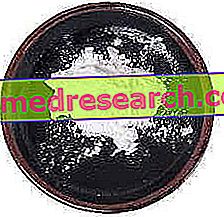Generality
The chemical yeast is an edible product aimed at the production of food, based on flour, which must increase in volume and decrease the density (such as bread, pizzas, focaccia, some desserts etc.).

The preservation of the chemical yeast does not require large measures and, if hermetically sealed, it can be "forgotten" in the kitchen cabinets even for a long time without affecting its activity. The only essential factors for the maintenance of chemical yeast are: low humidity and not high ambient temperature; it goes without saying that a package of chemical yeast still sealed and sealed, if stored in the pantry, can last for several years. To check the molecular integrity of the chemical yeast, simply pour the tip of a teaspoon into hot water; if it still shows a good effervescence (similar to an effervescent aspirin tablet) it can be defined as "still good".
There are different types of chemical yeast. Some are useful for leavening already at room temperature, others are characterized by a hot activation. Moreover, although the interactions are similar, the active ingredients of chemical yeast are NOT completely the same.
The big differences between chemical and natural yeast are two:
- The chemical yeast is ready to use, therefore faster to use but with an equally limited raising action
- The chemical yeast is tasteless; it therefore lends itself to recipes that do not require the typical hint of alcohol and lactic acid, but for the same reason it is not suitable for baking where instead these requirements are essential.
Below is an example of a recipe with instant chemical yeast
Rustic focaccia with whole wheat flour
X Problems with video playback? Reload from YouTube Go to Video Page Go to Video Recipes Section Watch the video on youtubeWatch other video recipes based on instant yeast
Composition and Operation
Chemical yeast is a mixture of: an alkaline base, an acid base and (for storage) a dehumidifier.
The most widespread alkaline base is sodium bicarbonate, while the dehumidifier par excellence is starch (of corn, potato, etc.). Today, chemical yeast exists with early activation (at room temperature), slow activation (in cooking) and mixed activation (double action). The latter are the most widespread because they guarantee the success of almost all the recipes.
The variable of the various types of chemical yeast is above all the mixture of acid bases; it being understood that it is possible to manage its composition by means of the ingredients contained in the preparation (lemon juice, vinegar, yogurt, etc.), the acid bases of an early nature are: tartaric acid, potassium bitartrate, monocalcium phosphate, etc., while late ones are: dicalcium phosphate, sodium sulfate and aluminum etc.
The mechanism of action is quite simple and the same for everyone; the only differences are the speed of the reaction and the condition of maximum activation (temperature). In summary: with the presence of water (better if at room temperature and higher) the acid base yields the hydrogen ions to the alkaline base and recombine originating: carbon dioxide, water and secondary compounds such as (assuming the interaction between sodium bicarbonate and potassium bitartrate) sodium tartrate.
1st CURIOSITY
Probably, some of you, reading the name BITARTRATO DI POTASSIO had a strange feeling of " deja vu ". In fact, wine lovers will more than once have the opportunity to taste a "homemade" wine and, in good faith, to pour the last glass of the bottle. Madornale error! On the bottom of certain wines, when not decanted and filtered, the tartrates (naturally present in grapes or lawfully added in the form of bitartrate as acidity regulator) crystallize; they are totally tasteless but to the touch they strongly resemble the very common sand.
2nd CURIOSITY
In a similar way to the previous case, some sportsmen will be convinced to re-read a topic already deepened in other areas. In fact, it's not wrong! The chemical reaction described is not very different from that which occurs in our organism in conditions of acidosis. The lowering (obviously modest) of the pH during sports performance, probably induced by the increase in lactic acid in the muscles and blood, triggers the release of the body from bicarbonates acting as a "buffer". These, capturing the hydrogen ions of lactic acid / lactate, strongly reduce the acidifying action.
Homemade chemical yeast
Yes of course. It is obvious that its effectiveness will never be comparable to that of a commercial product, especially if it has a double action and consists of different acid bases. However, by perfecting the doses of the ingredients on each recipe, it is possible to obtain amazing results.
To obtain a good chemical yeast it is necessary: sodium bicarbonate, in an amount of about 2-5g per 500g of dough, and an acid component. Regarding the latter, there is plenty of choice; they are common ingredients: white vinegar (acetic acid), lemon juice (citric acid), yogurt or other fermented milks (lactic acid). As specified, the quantity of acids must be established based on the ingredient and the specific recipe.
WARNING! In recipes with commercial chemical yeast that involve the use of lemon juice or vinegar or yogurt, it is necessary to compensate for the increase in acid bases through the integration of sodium bicarbonate.
Instant Yeast - 3 ways to prepare it at home
X Problems with video playback? Reload from YouTube Go to Video Page Go to Video Recipes Section Watch the video on youtube



